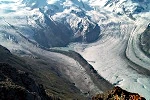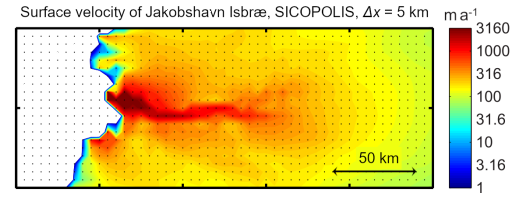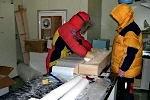


Dynamic and thermodynamic behaviour of ice sheets and glaciers
Ralf Greve, Shin Sugiyama and Masahiro Minowa
Inland ice sheets and glaciers are an important dynamic part of the Earth's climate system on the time scale of decades and beyond. More than 90% of the terrestrial freshwater reserves are stored in these ice masses. Their complete disintegration would lead to a global sea-level rise of approximately 70 meters and would have severe impacts on the atmospheric and oceanic circulation. Against the background of future global warming due to ongoing emissions of greenhouse gases, research into the behaviour of ice sheets and and glaciers is of great relevance.
We conduct numerical simulations and field observations in order to reconstruct the evolution of ice sheets and glaciers in the past and predict their future changes. Dynamic/thermodynamic ice sheet models are used to investigate the glaciation of the northern hemisphere during past glacial-interglacial cycles, the past and present state of the Antarctic and Greenland ice sheets, and their response to future global-warming scenarios. Flow simulations are also an important tool for dating ice cores drilled in Antarctica, Greenland and ice caps in high mountains.
In order to better understand the physical processes which control the changes of ice sheets and glaciers, field measurements on ice dynamics, glacier hydrology and mass balance are performed in the Alps, Kamchatka, Alaska, Patagonia and Antarctica. Field data are analyzed with the aid of numerical simulations and laboratory experiments. A new field of research is the study of extraterrestrial ice masses like the Martian polar caps or the suspected icy shell of the Jovian moon Europa.
Ralf Greve
- For further information, please see Ralf Greve's website.
Shin Sugiyama
- Three-dimensional numerical modeling of Shirase Glacier drainage basin in the East Antarctic ice sheet [Japanese].
- Physical structure of snow surface in the Antarctic ice sheet [Japanese].
- Investigation of glacier fluctuation mechanism due to the formation of an proglacial lake [Japanese].
- Mechanism of a drainage divide formation in mountain glaciers. [Japanese]
- Short-term variations in glacier flow at Perito Moreno Glacier, Southern Patagonian Ice Field, Argentina [Japanese].
Masahiro Minowa
Physical and chemical properties of ice cores and reconstruction of paleoenvironments
Yoshinori Iizuka
As a documentation of earth's history, ice core in polar ice sheets records paleoclimatic signals during several hundred thousand years. To accurately interpret the paleoclimatic signals, researchers must pay careful attention to the various physical and chemical processes that can alter ice-core properties. Our research group intends to examine how these processes affect climate information stored in ice core by using new tools and new methods for ice core analyses of x-ray and laser scattering.
Yoshinori Iizuka

